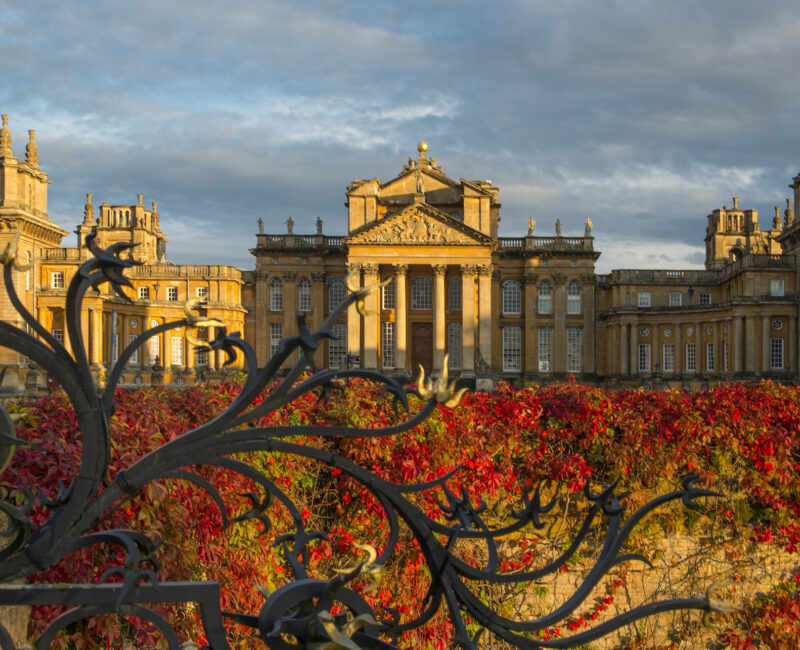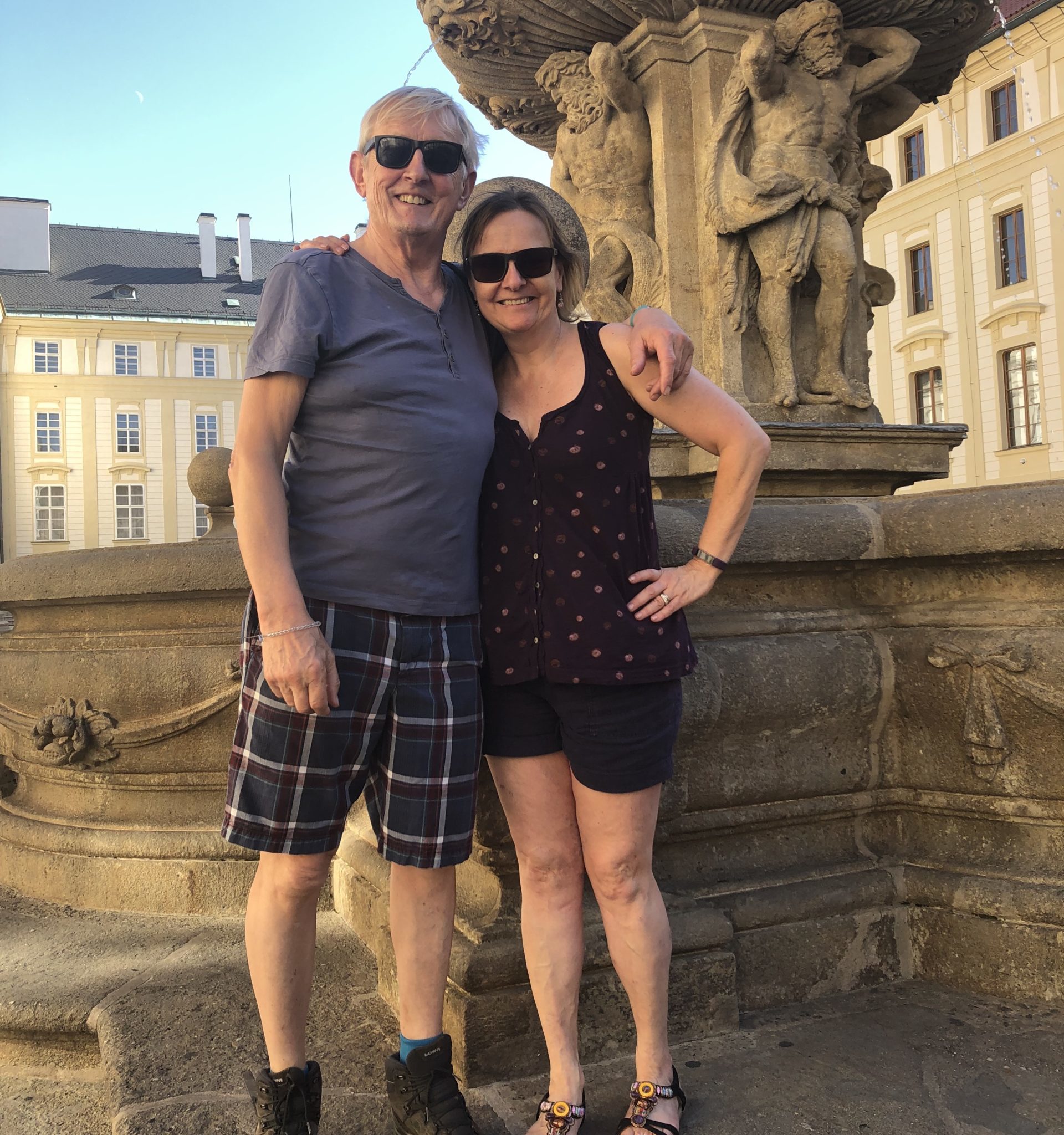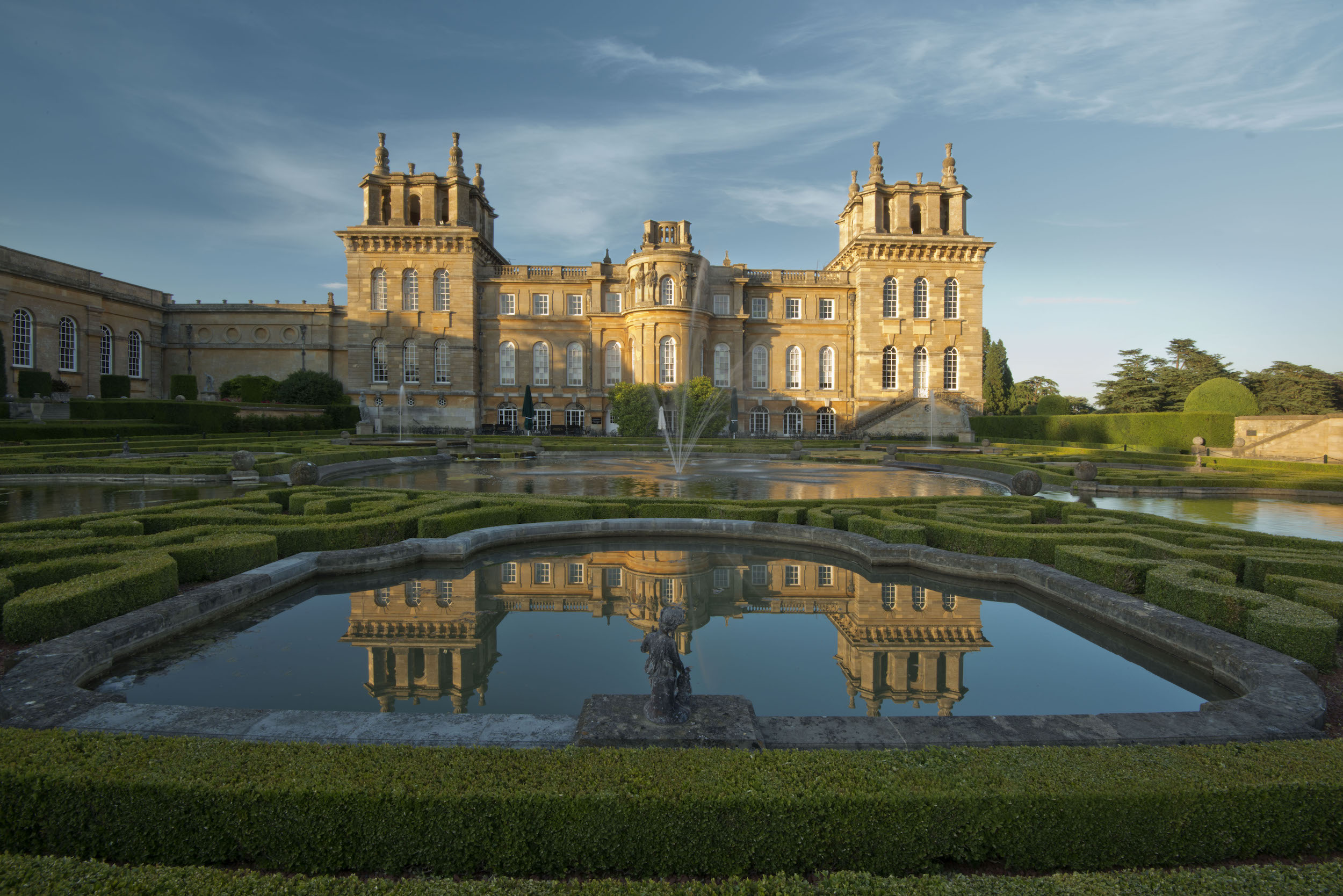
Peter Welcome to our travel podcast, we’re specialist travel writers and we’ve spent half a lifetime exploring every corner of the world.
Felice We want to share with you some of our extraordinary experiences and the amazing people we’ve met along the way.
Peter This week were basking in summer sunshine at Blenheim Palace, which is set in thousands of acres of rolling parkland outside the village of Woodstock in Oxfordshire. Big? It’s bigger than Buckingham Palace, but it’s also privately owned by the family that built it over 300 years ago. It’s been the seat of the Dukes of Marlborough since 1704. It was also the birthplace – by accident – of Sir Winston Churchill and thereby hangs a tale, as the great man himself said later in life: ‘Although present on the occasion, I have no recollection of the events leading up to it.’
Felice We’re here to meet social historian, Antonia Keaney, who hopefully will reveal all, but the first we’ve got to actually get there. Everything here is on a palatial scale. The walk down a tree-lined carriageway from the car park to the house is only half a mile long, but the gardens and park on the other side of the building and it’s an enormous stretch that double that distance.
Peter Antonia here we are in the grounds of Blenheim Palace. Tell us a little bit about it and when was it built?
Antonia Blenheim Palace was built in 1705 – in fact, the first brick was laid in June 1705, so we’re approaching its anniversary and it’s here because of the first Duke of Marlborough, John Churchill. Now, John Churchill was a great leader, a great general, and he led the Allied forces against the French in the Battle of Blenheim in 1784. And it was such a decisive battle in the war of Spanish succession that Queen Anne gifted him 20,00 acres of land and £240,000 pounds with which to build this magnificent palace.
Peter Which was a lot of money in those days.
Antonia I mean, 70, 80 million, I don’t know. It wasn’t quite enough to build the palace and the Churchills had to dig into their own pockets to the tune of £60,000.
Peter Again, a huge amount of money,
Antonia A huge amount of money. But then it is a huge amount of palace if you look at it. And it’s quite splendid. The grounds were later on landscaped by Capability Brown; he was commissioned by the fourth Duke of Marlborough in 1764 and created this magnificent lake, which gives a proper setting to Vanbrugh’s grand bridge. John Vanbrugh was the architect for Blenheim. The Grand Bridge itself is magnificent and it contains secret chambers, which I think people always find rather intriguing. And the chambers – there are over 30 of them – some of them have fireplaces, some of them have panelling; but of course, the lower rooms now are all flooded because of the lake. Originally, the bridge used to span the River Glyme, but then when Capability Brown came, he dammed the river, filled the lake, and you have the landscape that you see here today.
Felice How big is the lake?
Antonia Oh, my goodness, I asked someone that quite recently and I think it’s something like 150, 200 acres. I mean it is absolutely vast and there’s nowhere on site where you can see it in its entirety; you have to be airborne to do that. But it’s absolutely magnificent home to all sorts of wildlife, as you can see. Really beautiful.
Peter Yes, we’re only eight miles or so from Oxford, but it’s the countryside is quite magnificent.
Antonia As you say, you could be in your own little paradise here and you can’t hear the road noise, you can’t hear outside sounds and things. It’s just like being in a really lovely bubble, not a Covid bubble, but just a nice bubble.
Felice Antonia, what is your job here at Blenheim?
Antonia I joined 13 years ago now and I was part of the education team here at Blenheim and then my job changed slightly and I concentrated on social history more. So I found and interviewed various people that have connections with Blenheim, dating back as far as the Second World War and even earlier, and I research and I help with exhibitions and give talks and all sorts of things. It’s marvellous.
Felice Shall we walk on?
Peter Yes, let’s walk on a bit.
Felice When people come here for the day can they just to go into the grounds?
Antonia Yes, they can. Locals have a have a walking pass, as it were. So people who live in Woodstock, which is the town where Blenheim is to be found, can just wander in at will. But yes, you can certainly just come to the park and gardens if you’d like to. There’s always something different going on, and obviously this past year has been a little bit tricky but they’ve started having outdoor events now and we’ve got we’ve had jousting recently. We have a dog show coming up, we have our flower show coming up. So they’re all things that bring people back again and again and again.

A jousting tournament at Blenheim
Felice And is that archery I can see in the distance?
Antonia It is. Again, this is a temporary thing, we’ve got it for the next few weeks. But, yes, there’s archery and axe throwing, would you believe. So it’s always best to keep your distance I think. If you look across the lake and across the bridge – I mentioned it’s a Capability Brown landscape – and one of the things he did was to plant lots and lots of Cedars of Lebanon. This particular Cedar of Lebanon has that enormous hole in its trunk and it featured in Harry Potter and the Order of the Phoenix. It’s not the Whomping Willow, as many people believe, but it did feature in the scene when Snape, as a young man, was humiliated by Harry Potter’s parents…father and his friends. So we have people coming to see where various films were shot. We had Spectre – part of the James Bond franchise was filmed here recently. We’ve had Mission Impossible, Cinderella, all sorts of things.
Peter But here we get a dramatic view of the the enormity of it. It really is a very big building indeed, isn’t it?
Antonia A very big building. And it’s interesting, again going back to the 18th century, the fourth Duke was a very good friend of George III and George III visited with the queen. And he saw Blenheim in its magnificence and his comment was, ‘We have nothing to equal this.’ And so he set off back to his palace and made all sorts of additions and adjustments to try and bring it up to this. But I still think this is possibly bigger than Buckingham Palace.
Antonia Oh, I think so unquestionably.
Felice And how did it get the name ‘Palace’?
Antonia That’s a very good question. It is the only non-royal palace in the country. And looking back over various books and sources, it’s been referred to as Blenheim House, Blenheim Castle and now Blenheim Palace. There are various kind of theories on this and the one that I kind of stick to is the fact that the first Duke of Marlborough had various titles and amongst them was Prince of Mindelheim, and he was awarded this by the Holy Roman Emperor. So I suppose if he was a prince, then he’s almost entitled to live in the palace, so that we are. I mentioned that it was designed by John Vanburgh and It always amuses me that Vanbrugh was known as a playwright and then it’s as though one morning he woke up and thought, ‘Right, I’ve had enough of, you know, writing plays. I’m now going to start designing buildings.’ And he also designed Castle Howard. But if you look at Blenheim, it looks like a stage with wings either side, and what could be more theatrical? It’s just magnificent.
The courtyard, the first courtyard that visitors come into, is known as Kitchen Court. If you like, that’s the utility area, so that’s where the kitchens were originally: the dairy, the laundry, the bakery, etc, and also a huge orangery so that citrus fruits could be grown. Then you have Great Court, which is in front of the house itself, and then it leads onto the stable courtyard which is where the coaches were housed, where the horses are stabled, etc. So each bit has its purpose.
Peter Right, let’s walk on inside. Looking back through the gates now behind us, there’s a quite enormous colonnade. What you describe it as?
Antonia We call it the Column of Victory and it was commissioned by Sarah, the first Duchess of Marlborough, in honour of her husband. So the first duke died in 1722 and Sarah was a widow for 22 years. And so she had this and it is a magnificent column, the base details all of her husband’s victories. And on top of the column is John Duke of Marlborough, dressed as a Roman emperor, looking down on his palace.
Peter And it’s quite deceptively a long way away, isn’t it? So I suspect he’s probably a good three-quarters of a mile away, just about a mile?

The palace, the lake and Grand Bridge
Antonia Yes, you’re absolutely right. And it’s double the height of the Great Hall you’ll see when we’re going to the palace. So I think it’s 134 feet tall and the Great Hall is 67. One of the things I love about looking at the palace as well is that you can read so much according to the windows. If you look, it has these great big enormous windows but if you look at the very top, just below the roof line, there are some teeny tiny square windows. And the smaller the window, the less important the person that inhabited the room in which the windows are set. So these tiny windows were the rooms where the lesser servants lived and the windows themselves are designed to let in light but they’re set up very high in the wall so that the person in there can’t actually look out and enjoy this wonderful view.
Peter Or be seen at a window.
Antonia Oh, my goodness, no, absolutely not. And likewise, you’ve got these circular windows at the bottom and the windows are in a corridor that runs around the entire perimeter of the palace. And again, that’s where the servants would get from A to B, and those windows are setting very high on the wall so they can’t look out, but the light can come in.
Peter How many rooms are there in the palace in all, or is that a ridiculous question?
Antonia No, not at all. There are about…almost 200 and I say ‘almost’ because occasionally we come across another one, that we weren’t sure existed. And we’re still looking for the laboratory that was used by the 8th Duke of Marlborough. We still haven’t found it. It’s on the billboard, but we don’t know where it is.
Felice How many people would have lived here in its early history?
Antonia So, again, I keep harking back to the 4th Duke, and he was here from from 1758 until 1817. His was the first family to live here full time and they had about 70 or 80 indoor servants and the same number outdoors. So it literally did house hundreds of people at one stage – in the palace itself, in rooms above the utility area, in rooms above the stables, and at various points on the estate.
Peter So now we’re going inside.
Antonia This is the Great Hall and you can see now that the Column of Victory must be enormous if it’s twice the height of this.
Felice A marble floor, black and cream, huge archways, statues all over the place…who are the statues?
Antonia The statues actually used to belong out in the garden, we have a roundel and then they were brought inside there, not by anybody in particular, as far as I know, but they’re a really beautiful niche there, I think.
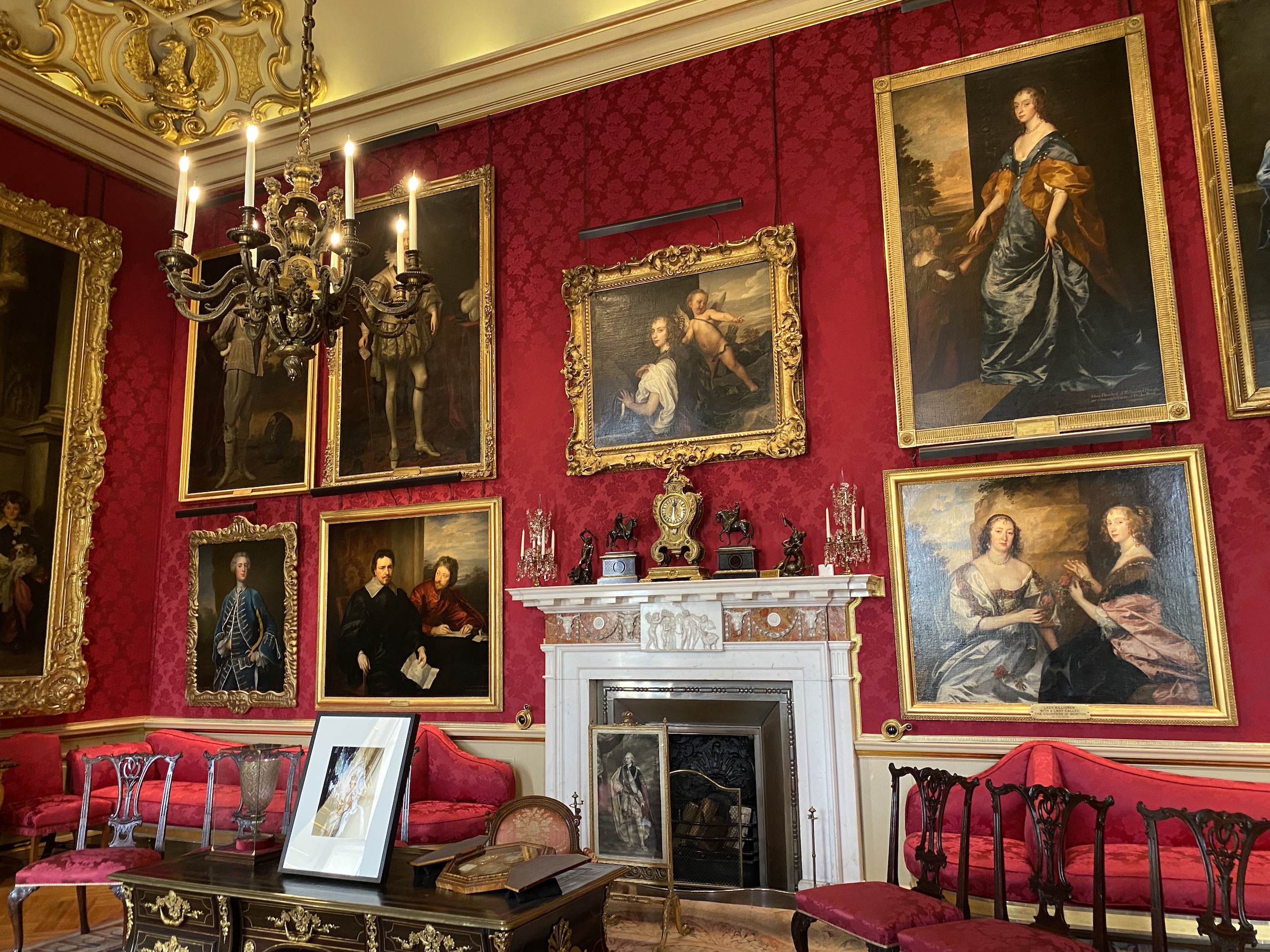
The Red Drawing Room. Photo: © F.Hardy
Peter So what have we got here?
Antonia We’re in one of the state rooms that people will see when they visit the palace. And this particular one is one of my favourites – it’s the Red Drawing room and you can see it’s dominated at one end of the room by the most amazing painting by Joshua Reynolds. Again, it’s of the 4th Duke and his family. Then it faces one by John Singer Sargent and that one shows the 9th Duke of Marlborough who was duke from 1892 until his death in 1934. But what’s particularly interesting about this is that it shows him with his family and his wife, Consuelo Vanderbilt, as she once was. She is one of the numerous American connections that Blenheim has.
The Duke’s stepmother was also an American lady called Lily Hammersley. There’s a rather rather sad, rather poignant story attached to their marriage. So they were married in 1895, and it was very much Consuelo’s mother’s ambition that Consuelo should marry into the British aristocracy. So when the Duke proposed to Consuelo, Consuelo turned him down. So Alver took to her bed with a fit of the vapours and palpitations, and Consuelo was a very beautiful young girl, and she agreed to the marriage and she wrote an amazing memoir called The Glitter and the Gold. And in it, she describes the morning of her wedding and she said that she cried all morning and it was all they could do to to camouflage the redness of her eyes.
They were married and the Duke wasted no time in telling Consuelo that he was actually in love with someone else. And Consuelo had also thought she was engaged to someone, but she did her duty. She produced an heir and a spare, but they did separate and then they were divorced in 1921 and they both remarried. Consuelo married very happily a French aviator called Jacques Balsan, and the Duke married another American lady called Gladys Deacon, and that ended in tears.
Peter Let’s walk on.Where are we now?
Antonia So we’re in the saloon, which is the formal dining room, and you can see that the walls are completely painted. And they were they were painted by an artist called Louis Laguerre, and he did the whole lot for £500, which the first Duchess had far better value than James Thornhill’s ceiling, for which he charged over £900.
Peter This is where they would have had formal dinners?
Antonia Very much so.
Peter That’s a large dining table in the middle, a beautiful table with candelabra.
Antonia It’s for formal dinners and and the Duke would have his Christmas dinner here with all his guests. The butler assures me he can get 42 people around the table when it’s extended to its full length, but it’s a bit tricky with the side plates.
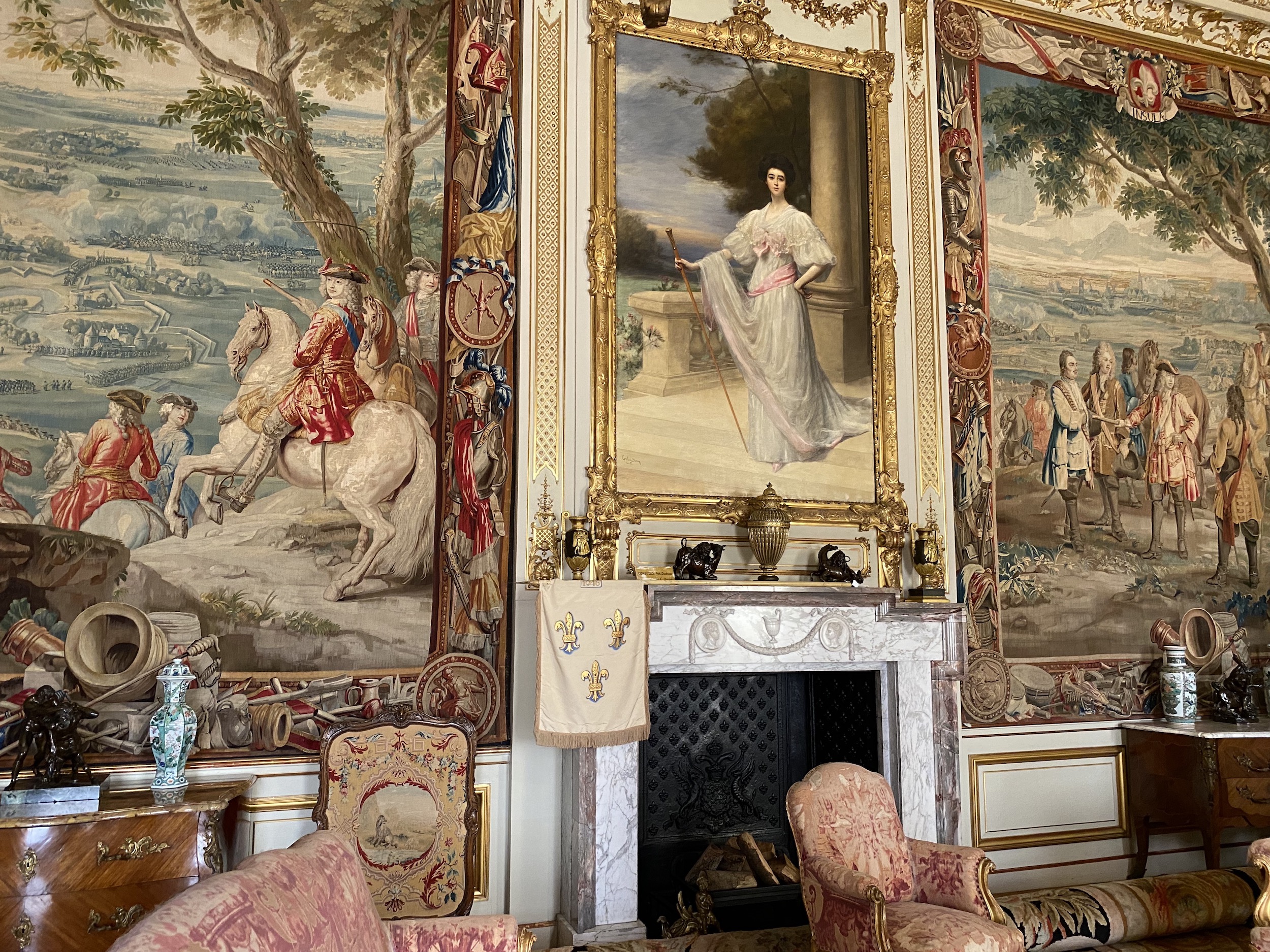
Tapestry room. Photo: © F.Hardy
Felice Well, the last room we went through was amazing, with frescoed walls and ceiling. And this one looks like tapestries.
Antonia That’s right. And so these tapestries are part of a collection that were commissioned by the 1st Duke of Marlborough and they record his military successes. So there are over 300 years old and you can see they’re in absolutely fantastic condition. They’re marvellous – when you when you look at them and you look at the detail, they were absolutely top notch at that time. The other things in this room, there’s a wonderful portrait of Consuelo again by Carolus-Duran. This was before she was married; it was a picture that was commissioned by her mother and the room itself we call the First State Room, and it’s one of a suite of three rooms. This suite would be at the disposal of any visiting head of state or member of the royal family. This would have been the ante room – so meeting and greeting. The next room would have been the sitting room and then the final room would have been the bedroom and it overlooks the South Lawn and you have views all the way to Bladon, and you can see the church tower and that’s where Winston Churchill was buried.
Peter So what have we got here?
Antonia Now we’re in the Second State Room and this room is dominated, strangely enough, by a portrait of Louis 14th. I mentioned that the 9th Duke of Marlborough married Consuelo Vanderbilt, and the reason behind that really was that Blenheim was in need of some upkeep. So he spent some of Consuelo’s money on redecorating these three rooms and when he did, he put this portrait up of the Sun King. The reason that it relates to Blenheim is that Louis 14th was on the throne at the time of the Battle of Blenheim when John Churchill defeated the French.
But it always makes me smile that when the Duke had these rooms decorated, he really didn’t like the result. He thought they looked too French at the end of the day, so it wasn’t money well spent. But one of the tapestries in this room is fascinating, I find. It’s one of the Bouchon tapestries and it’s the only one that has a dog. And you can see that the dog is following a man on horseback, and the man is Lord Cadogan, who was a very good friend of the 1st Duke. That was his dog and he used to take it into battle with him, and the Duke felt that he was worthy of a place in history and a place on the tapestries.
Peter He got his place.
Antonia He certainly did. But it’s interesting because I don’t know quite what happened, because the weavers have given him hooves instead of paws. There’s a number of reasons: it’s either a genuine mistake, because the way these are woven – they’re not woven horizontally, as it were, they’re woven vertically – so you don’t really know what you’re doing in the entirety and it could just be a genuine mistake.
Peter I should think hooves on a dog in a battle, in a war, would be rather good things.
Antonia It could be protection. But I had a group of quilters here once and they said to me that sometimes people will put deliberate mistakes in because: ‘Only God is perfect.’
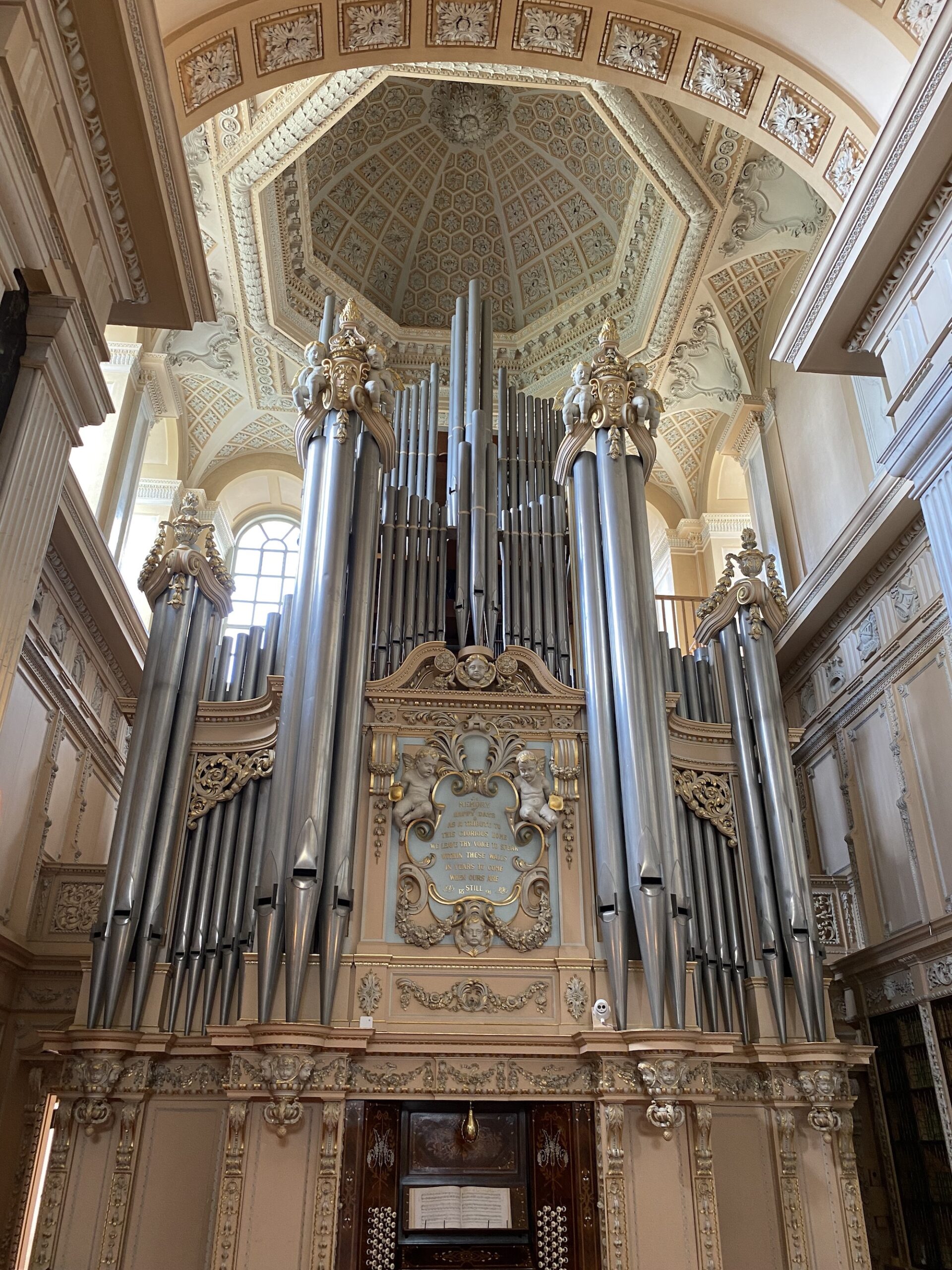
The organ at Blenheim Palace. Photo: © F.Hardy
Peter That sounds like a very good answer. I’ll try that one myself. Right, let’s go on. This room is an enormous room with an organ at the end of it. Can you tell us why this is so?
Antonia We’re in the Long Library now which is, as you say, an absolutely magnificent room. At 184 feet long, I believe it’s the second longest room in any private house in the country. Down one end we have a statue of Queen Anne…again, very important for Blenheim: she was the lady who gave the land and the money. Then down the other end of the library we have the most magnificent Willis organ with its 2,300 pipes still played regularly. That was placed here in 1891 by the 8th Duke of Marlborough. But this room is also important to us because it was one of Winston Churchill’s favourite rooms.
Peter So Blenheim Palace is essentially known to lots of us as the home of Winston Churchill, or rather the birthplace of Winston Churchill. Tell us how that came about as there’s a bit of a story attached to it, isn’t there?
Antonia Yes, of course. And you’re absolutely right. People do think it was his home, but it wasn’t technically, but it was certainly his birthplace. It wasn’t meant to be; he should have been born at the home of his parents in London. But Jenny Jérome, his mother and Lord Randolph were here for a St Andrews Day ball. And of course, in those days when you visited somewhere, it was a long-haul thing; it wasn’t easy to travel from London to Woodstock, so you stayed for several days. Jenny had taken a ride out with the beaters in a carriage during the shooting season. Churchill was born on the 30th of November, so very much that time of year, and that’s what they believe brought on the labour pains, because he was premature. So Jennie went into labour. As I mentioned, there was a ball going on in the Long Library, so they made her comfortable in a room that was being used as a cloakroom and lo and behold, Winston popped along several hours later.
Peter And a bit of confusion here, because ‘cloakroom’ means two things, doesn’t it? In the terms of a stately home like this, a cloakroom would be quite literally somewhere where you hung your clothes and your overcoats, your outer garments. It wouldn’t be the ladies loo, which is often been referred to.
Antonia Winston Churchill was not born in the ladies loo, I can assure you. So no, it was, as you quite rightly say, it was being used as a room for cloaks, for outer garments. And there’s a wonderful letter that Lord Randolph, his father, writes to Mrs Jérome, his mother-in-law, and he describes the events and says that they couldn’t get hold of the London doctor but the local doctor managed very well. They didn’t have any baby clothes ready for him, so they had to borrow clothes from the local solicitor’s wife. He ends by saying that despite its premature-ness, the boy is wonderfully pretty. Now, I love the fact that Churchill is described as being pretty, because I think that’s probably the one and only time in his life that he was.
Peter I think that’s right. And there’s also a suggestion which no one would ever know the answer, that premature might have been a bit of a story to disguise the fact that it is possible his mother might have been pregnant at the time of the wedding.
Antonia You may think that but I couldn’t possibly comment, but you’re quite right: they they married in April 1874. Winston was born on the 30th of November, 1874, and they married after quite a whirlwind romance in fact. They met the previous year in Cowes on the Isle of Wight and Randolph proposed to Jenny on their second meeting.
Peter During his lifetime, Winston Churchill, was a regular visitor here?
Antonia Absolutely. And I think the reason people think that he lived here was that he did spend an awful lot of time here. So if you remember, his father, Lord Randolph, was a very successful politician and he and Jenny would have travelled extensively in support of his career. And so Churchill, like many children, was left with his grandparents. So he had the run of the house, he had the run of the grounds and he certainly learnt to ride here. And there are some wonderful letters where he’s writing to his parents and he very proudly says that he rode Rob Roy his pony round the grounds. There are times when he was under the care of his nanny, Mrs Everest, and he mentions that he found hyacinths and he found a snake down by the cascades and Mrs Everest wouldn’t let him hit it over the head with a stick, and this sort of thing. So he spent many, many happy days here. Then later on, of course, his cousin was the 9th Duke, so he was invited all the time for social events. And at the beginning of the 20th century, Churchill spent a lot of time here researching the life of his ancestor, John Churchill.
And so, again, he was accommodated by his cousin, the 9th Duke, so he was here all the time and he was very proud of the place. Of course, then in 1988, it’s where he chose to propose to Clementine Hozier. And he very deliberately wanted this to be the place he proposed. You know, he was showing Clemmy his heritage, what he had to offer. He’s buried very nearby in a village called Bladon and in fact, it’s only about a mile away. And if you look out of the windows, which overlooks the South Lawn, you can look across the expanse, you can see the tower of the church where he’s buried. So he’s in sight of his beloved palace. He had wanted to be cremated, but because he was going to have a state funeral, that wasn’t an option. And that’s when he decided that he would be buried at Bladon, and that’s where his parents are buried, his brother, his children – so that that was the thinking behind his choice.
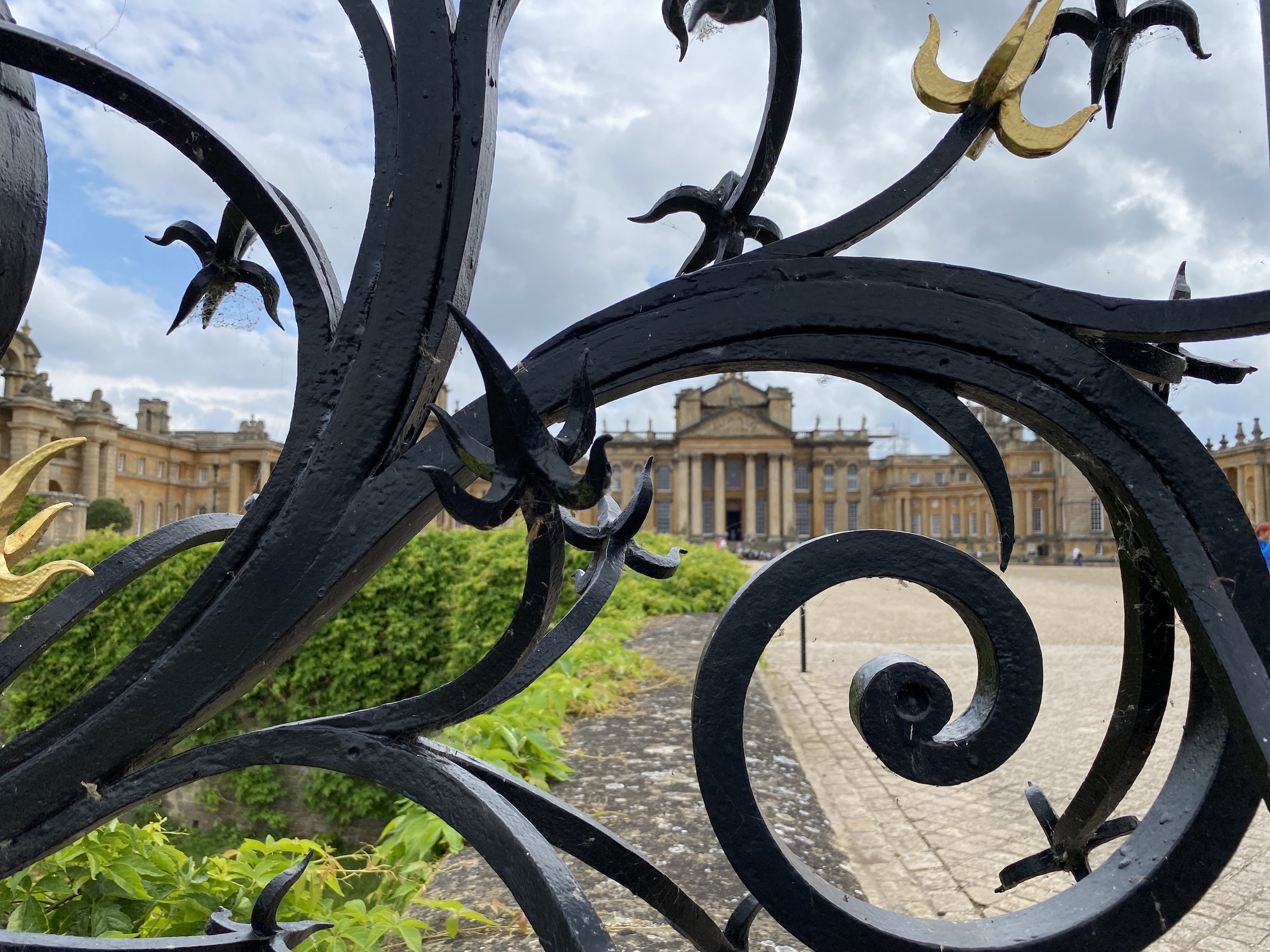
Photo: © F.Hardy
Felice Is there a statue of Churchill here at the house?
Antonia Yes, there are several in actual fact, there’s one in the garden. We have a Churchill Memorial Garden and there’s a wonderful bust of Churchill. We’ve recently opened a brand new Churchill exhibition and we’ve commissioned a waxwork of him so you can actually stand next to this life-sized figure and have your photograph taken alongside him. And there are various paintings and little statues around the house as well.
Peter Coming outside again, we can nw say we’ve actually barely touched one tiny corner of it.
Antonia Absolutely, though, there’s still so much to see in terms of the gardens. We do on occasion allow visitors to go into the private side as well. And again, that depends very much on whether the Duke’s in residence or not, as you can imagine. And again, we do have certain restrictions at the moment.
Peter But it’s still very much a family home?
Antonia Oh, yes, very much so. And it’s privately owned still.
Felice We’re in the stable courtyard now. And I’ve just asked Antonia, when did they stop keeping horses here?
Antonia Horses were kept actually over in the stables, which is the area just to our right, up until about 20 years ago. In fact, we’ve just revamped the stables and we’ve we’ve restored them back to how they were. You can walk around now and it’s very evocative. You can really imagine what it was like, and the coach house there where the carriages were kept, etc. And we’ve got this lovely new restaurant. So, you know, hopefully our visitors will enjoy seeing that. We’ve also something we’re really, really excited about: back in the 1980s, the Duke bought a brand spanking new Merryweather fire engine, so steam-driven, and it was at Blenheim until the 1970s. Then I’m not quite sure what happened to it, but we’ve just found out where it is and it’s due to come home.
Peter That’s wonderful.
Antonia It’s really exciting; I can’t wait to see it.
Peter Antonia Keaney, thank you very much indeed for showing us around and we hope you have a wonderful summer here.
Antonia Thank you very much. It’s been a pleasure.
Peter Felice, let’s take a wander down to the water gardens overlooking the lake where a particular fountain you want to take a look at.
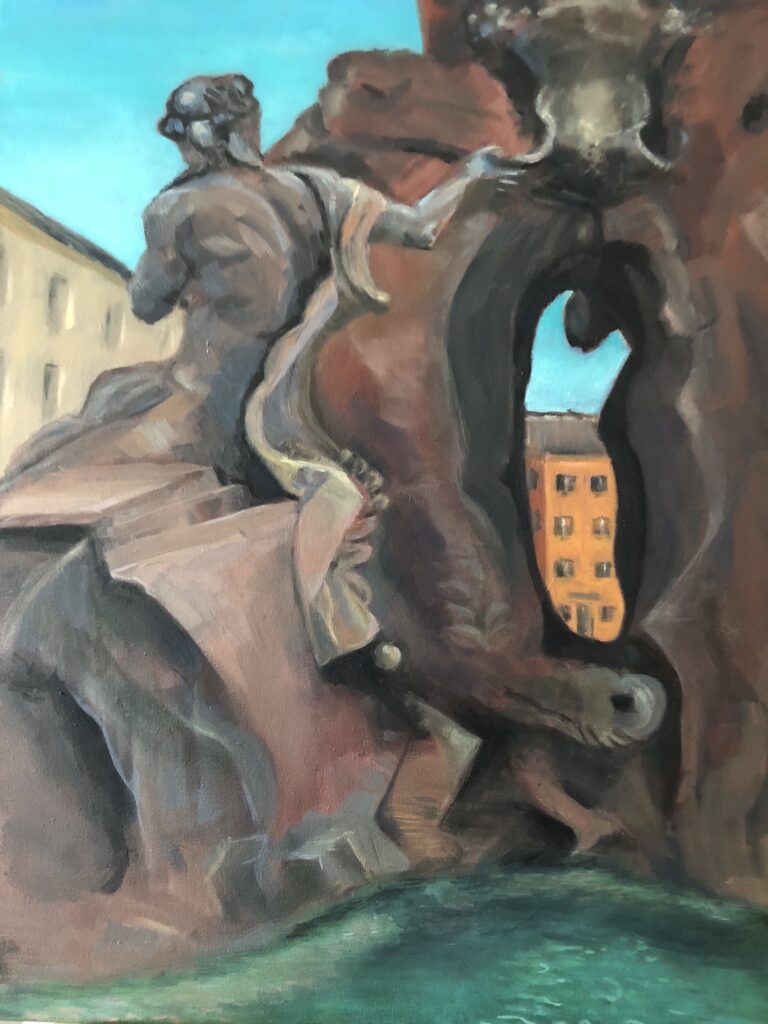
Piazza Navona in Rome. Painting © Felice Hardy
Felice The fountain I’m interested in is one that is modelled on the Bellini Fountain in the Piazza Navona in Rome, which by coincidence, I painted a few years ago. This is a mini version. Oh, wow, it is tiny. It’s a perfect copy of the one in Rome but as I said, much, much smaller. Actually, I might put my painting of the Rome version on the Show Notes so you can see it there.
Peter So time to go home. What do you think of a day out then in Blenheim Palace? Is it worth it?
Felice I think the gardens are absolutely beautiful. And you could come here without even going inside the palace because you can see the palace, it’s spectacular. You can see it from outside and from wherever you walk. But I would love to just come here with the dogs, I’ve seen people with dogs, bring a picnic and sit in the beautiful grounds.
Peter I think of it all the gardens to me are much more exciting than the interior, which is beautiful, but it’s another stately home. But it’s but the gardens are absolutely spectacular and the building outside is amazing. The setting is grandiose on a scale that is almost impossible to imagine.
Felice You can see why it’s one of the most popular tourist sites in Britain.
Peter I think a lot of people think it’s Downton Abbey. It’s not. Of course, Downton Abbey was filmed and created at Highclere Castle in Hampshire. Winston loved Blenheim Palace. And there’s little doubt in our minds that this inspirational stately home where he spent so much of his childhood with his grandparents had a profound influence on his extraordinary life. Curiously, in a parliamentary speech in October 1943, Winston said, We shape our buildings and afterwards our buildings shape us. At the time, he was talking about the bombed out House of Commons. Or was he? Woodson’s also quite the same problem. I took two very important decisions to be born and to marry. I’m content with the decision that I took on both occasions. Certainly, it’s a remarkable place.
Felice If you want to find more about Blenheim Palace and book tickets to have a day out here and go to the website, which is www.Blenheim Palace.com
Felice That’s all for now. If you’ve enjoyed the show, please share this episode with at least one other person! Do also subscribe on Spotify, i-Tunes or any of the many podcast providers – where you can give us a rating. You can subscribe on Spotify, Apple Podcasts or any of the many podcast platforms. You can also find us on Twitter, Facebook and Instagram. We’d love you to sign up for our regular emails to [email protected]
Also see our post and listen to our episode: How to spend a Day at Warwick Castle and A Complete Guide to Stonehenge.
© ActionPacked Travel
![]()
- Join over a hundred thousand podcasters already using Buzzsprout to get their message out to the world.
- Following the link lets Buzzsprout know we sent you, gets you a $20 Amazon gift card if you sign up for a paid plan, and helps support our show.

